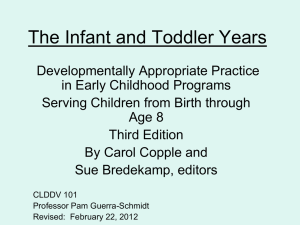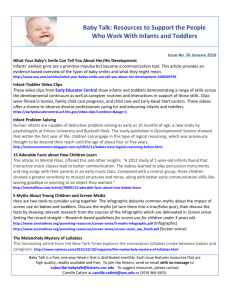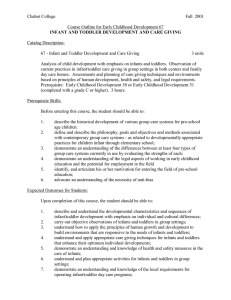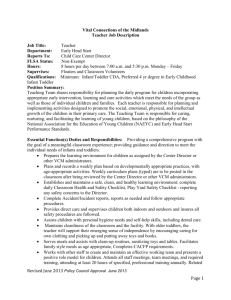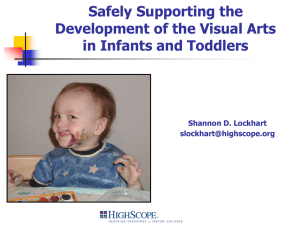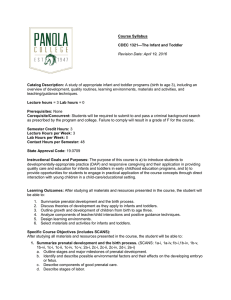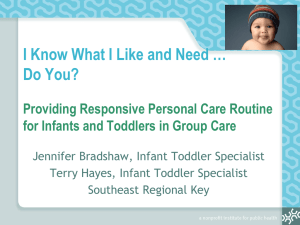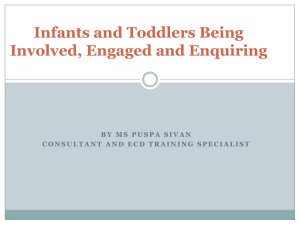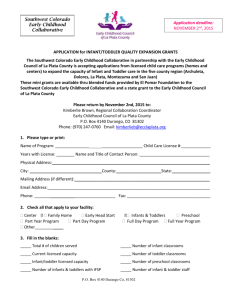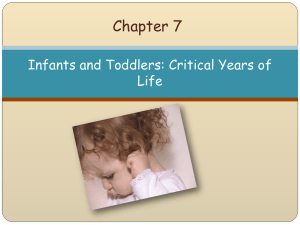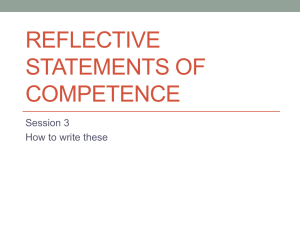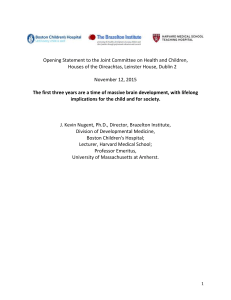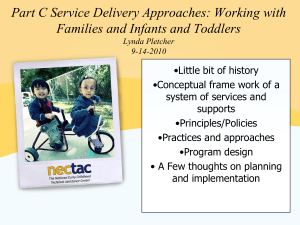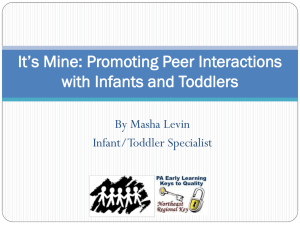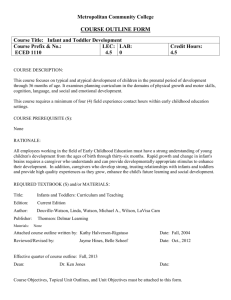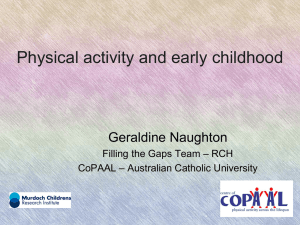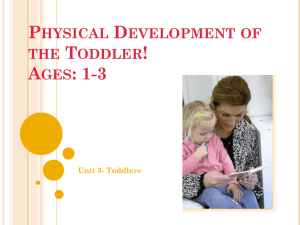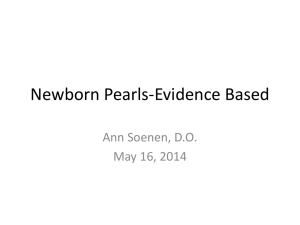Guidelines for Arranging and Equipping the Infant
advertisement
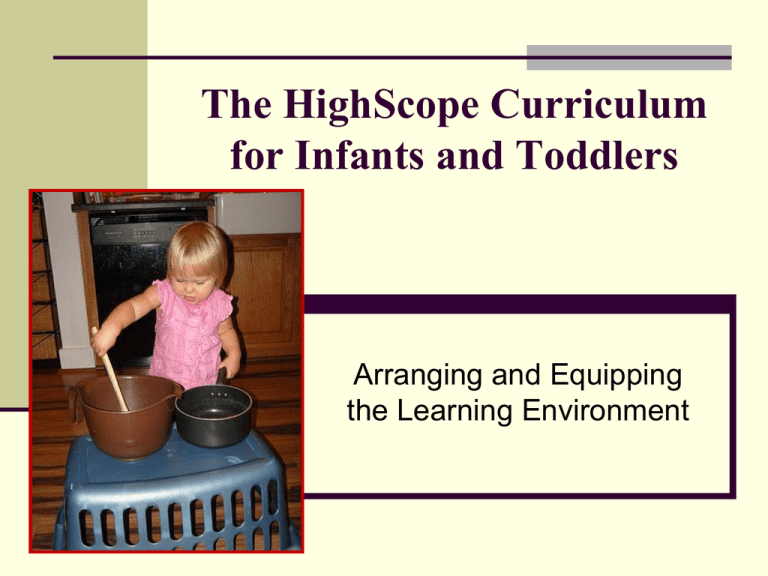
The HighScope Curriculum for Infants and Toddlers Arranging and Equipping the Learning Environment Objectives Identify qualities that characterize infant and toddler learning environments. Identify guidelines for arranging and equipping the play and care space for active learners. Design an infant and toddler environment that meets the guidelines. Assess play and care spaces for infants and toddlers. Identify materials for sensory-motor learners. 2 Your Current Space 1. Draw a diagram of your current indoor space. 2. Hold on to these drawings for an activity later on this afternoon. 3. Discuss: What are the differences between a preschool and infant and toddler space? 4. We need to create an environment that is right for infants and toddlers and that will stimulate their growth and learning. 3 HighScope’s Infant and Toddler “Wheel of Learning” 4 A Desirable Place to Be for Adults Close your eyes and imagine a pleasant place you would like to be right now. How does this place look, feel, smell? What features does it include? Who, if anyone is there with you? As a group, let’s compile a list. 5 The List What strikes you about this list? Which of these words and phrases go together? These words describe where we CHOOSE to be. Given a choice, we choose places where we can play, learn, eat, rest, go inside and outside at will, be alone or with others. 6 A Desirable Place to be for Children Find a new partner. Compile a list of words and phrases that describe where you think infants and toddlers most like to be. As a whole group discuss: What strikes you about this list? What is the relationship between the adult list and the child’s list? How does this help us begin to think about arranging and equipping the environment for infants and toddlers? 7 Envisioning this Space Imagine transforming this space into a desirable space for infants and toddlers. Turn to page 12-13 in your Training Booklet (TB). Follow the instructions and when you are done, draw your final arrangement on chart paper. Present to the whole group. 8 Guidelines for Arranging and Equipping the InfantToddler Learning Environment Turn to page 14 in TB. Gather information for your guideline. Watch Videos. Share as whole group. Guideline #1 Build order and flexibility into the learning environment with: A. Care and play areas that are distinct - Food preparation and eating, napping and sleeping, bodily care. - Places for social interaction, private spaces 1. Safe space for non-mobile infants. 2. Safe space for mobile infants. 3. Toddler play areas (movement, sand, water, book, art, block, house, toy). 10 Guideline #1 (cont’) B. An open floor plan. - Fixed specialized areas along the perimeter. - Middle space left open for active play. C. Moveable furnishings, equipment, and storage containers. D. Easy access to an outdoor play yard. 11 Guideline #2 Provide comfort and safety for children and adults with: A. Clean, inviting floors, walls, and ceilings. B. Soft places (pillows, couches, easy chairs, mats). C. Soft and natural lighting. D. Infant and toddler-sized equipment and furnishings. E. Adult-sized furniture. F. Storage space for caregivers’ personal belongings, children’s belongings, extra toys and supplies. - Children’s cubbies - Child-accessible shelves, containers - Adult-height shelves, cupboards, hooks 12 Guideline #2 (cont’) G. Safe, convenient adult access to appliances and everyday supplies. H. A welcoming entrance or reception area. I. Pleasant reminders of home: - Children’s comfort items - Family photographs J. Space for children’s creations. K. A floor-level focus. 13 Taking A Look at Sample Rooms With your group, look through the example of an infant and/or toddler space. Using the guidelines, critique these spaces. Discuss what should be there and what needs to change. Discuss as a whole group. 14 Applying the Guidelines to Your Design of this Space Pull out your design of this space. Using the first 2 guidelines for arranging and equipping the environment, assess your strengths and decide on what modifications need to be made. Use pages 17-18 in TB to help you. Draw a new diagram using chart paper or use a different colored marker to note the way you want the room to look according to the guidelines. Share as whole group. 15 Infants and Toddlers at Play 16 Guideline #3 A. Materials that appeal to children’s senses - Things to smell, hear, touch, taste, see. - Open-ended materials (found/natural as well as commercial). - Things to mouth, reach, grasp, roll, carry, set in motion, fit together, pull apart, etc. - A many textured environment (indoor, outdoor surfaces; furnishings). - Interesting vistas (windows, skylight, aquarium). Guideline #3 (cont.) B. Space and materials for children’s movement - Variety in scale (equipment, furnishings, playthings). - Multiple physical levels. - Places to suit different activity levels: Active play Quiet, stationary play Phase 3 Finding: As the number and variety of materials in settings increased, children’s age-7 cognitive performance improved. HI Materials LOW HI Cognitive Performance © 2003 IEA Preprimary Project, High/Scope Educational Research Foundation Let’s look at these toys… In groups examine these toys: What strikes you about the learning opportunities with these toys? KDIs Let’s Go Shopping! Choose 1 person from each table, take a bag and fill your bag with different kinds of materials from the various types of materials. With your group, explore the materials using all your senses. What about these materials? Materials can either What strikes you about the learning encourage or opportunities with these play discourage construction materials? of knowledge and What distinguishes the 2 groups? interactions— What does thisTHE tell us about the kinds MORE THE TOY of materials that we need to provide DOES, THE LESS THE infants and toddlers? CHILD LEARNS! Open-Ended Materials Will allow more Key Developmental Indicators to take place. Will allow more Active Learning to take place. This leads to more intrinsic motivation. This leads to more brain development. Environmental Issues and Solutions With your partner discuss your assigned issue and come up with solutions that would work according to the guidelines. Use page 19 to record your answers. Discuss as a whole group. 23 Best Thing About Today! Turn to page 20. Read through these statements. On a sticky note, jot down the best thing about today and put it up on the wall. Remember to read the article “Babies Get Out: Outdoor Settings for Infant-Toddler Play” at the end of your TB for tomorrow. 24


